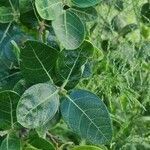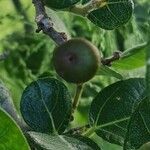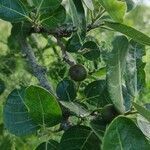A fig. It is a small tree. It is often bushy. The trunk is short and crooked. The bark is dark brown. The young shoots are rough and hairy. The leaves are 5-15 cm long by 2.5-5 cm wide. They are oblong. The leaves are thin. They have a sandpaper like texture. The leaves are dark green above and paler underneath. They taper to the tip. The leaf stalks are 0.3-1 cm long. They fruit or figs are 1-2 cm across. They are green but turn reddish-black and are fleshy. They grow from the trunk, the older branches and the axils of leaves. They are edible.




